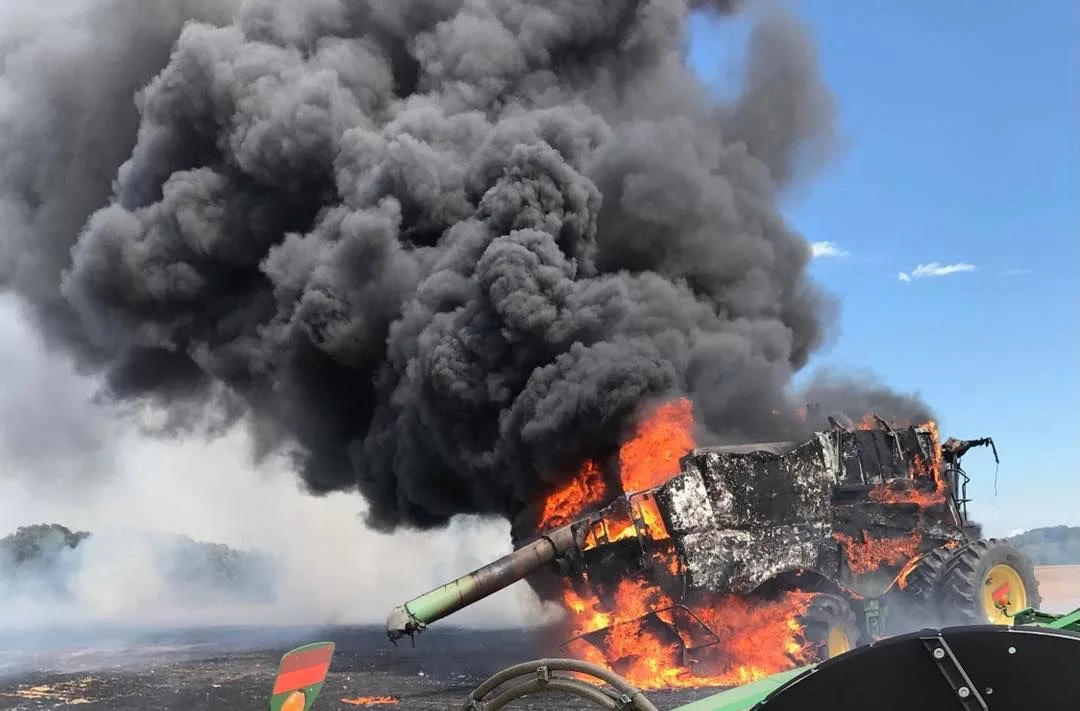
(Photo courtesy of the Kindred Fire Department)
Fargo, ND (AgNews890.com) – NDSU Farm and Ranch Safety Director Angie Johnson is warning Ag producers to be careful when operating Combines this Harvest season. Over the last 2 weeks she has been getting more reports of Combine Fires in the state. Johnson says doing proper maintenance can reduce your risk of a fire.
Here is a portion of the interview she did with farm Talk’s Erick Johnson:
Johnson urges farmers to consider the following tips for reducing the risk of combine fires while harvesting crops:
- Pre-operational checks. Take time to walk around the combine before the start of each day during harvest season. Use an air compressor or leaf blower every day when the machine is off and cooled down to remove dirt, dust, chaff and other plant reside that has accumulated. Always wear hearing protection, eye protection and respiratory protection, such as an N95 mask. While blowing off residue, look in high-risk areas, such as the engine and engine compartments, hydraulic pumps and pump drives, gear boxes, batteries and cables. When cleaning, take time to look for any issues that require repair, such as leaking hydraulic hoses that can be a perfect place for chaff to stick and build up, creating an easy fuel source for a fire.
- Take time to service the machine daily based on the combine’s operator manual. Grease and lubricate bearings and chains, and continue to look for areas that have excessive wear or damage.
- Watch for wiring issues. Today’s combines are controlled by many sensors and electrical components that are extremely complex. Take time to glance through wiring systems to see where wires appear to be unrestrained or damaged from rubbing or making contact with moving parts.
- Use an infrared thermometer. Hot bearings are a combustion source. Warm up your combine before taking it to the field and use an infrared thermometer to determine the operating temperature of your combine’s bearings. Safely open the combine’s shields, and from a safe distance, point the infrared thermometer at a bearing to read the measured temperature. If one bearing has a temperature much higher than the others, it may be worn or damaged. Plan to replace the bearing as soon as possible. Infrared thermometers are inexpensive (less than $50) and available at many hardware and farm stores. Another great time to check the temperature of the combine’s bearings is while you are waiting for the truck or grain cart.
- Install an air intake kit. An air intake kit allows clean air found above the combine’s “dust cloud” to enter the combine’s air intake screen, instead of taking in the dusty, dirt-filled air produced from harvesting the crop. Take the time to consider an option that will work best for you and your combine.
- Avoid combining during fire danger conditions. Avoid harvesting when it is hot and dry. Relative humidity values are low in the fall, increasing the risk of fire, especially in the late afternoon hours when temperatures rise. Limit the harvesting of soybeans that are extremely dry. Soybean moisture can get as low as 8% to 9% on a warm, dry afternoon. Keep an eye on outdoor air temperature and wind speeds. As hard as it is to shut down for the day when conditions are favorable for harvesting, shutting down when temperatures are hot and windy could prevent you from losing your combine to a fire. Be aware and find out if your area is in a fire danger zone by visiting: https://ndresponse.gov/burn-ban-restrictions-fire-danger-maps.
- Carry two, fully charged fire extinguishers. Ideally, you should have two 20-pound ABC fire extinguishers on your combine, one in the cab and one on the outside of the machine near ground level. Have them ready and operational, and review with workers how to use them when needed. Call 911 immediately to get your closest fire department on scene, as fires can escalate quickly.
- Create a soil perimeter. If you choose to harvest during high wind and temperature conditions, make a tillage pass around the perimeter of your field to prevent the possibility of a fire spreading to other areas.
- Strategically park harvest equipment. While harvesting a field, park your semis, trucks, pickups, tractors, grain carts, etc. in a place with minimal vegetation. Hot exhaust can be emitted from these vehicles and can start a fire in the ditch if dry grass is present. Before parking equipment and machinery in a shed or quonset for the night, let them cool down first to reduce the risk of a building fire.
For more information on crop harvest prevention techniques, visit: ndsu.ag/fireprevention.
